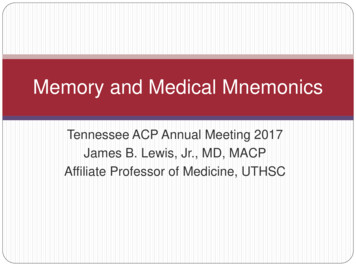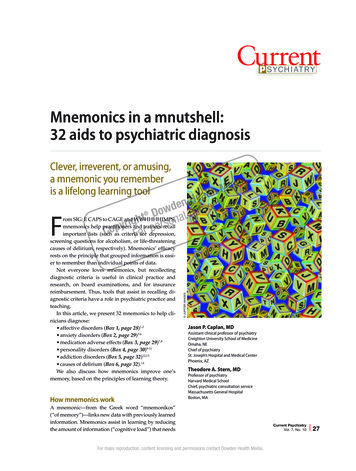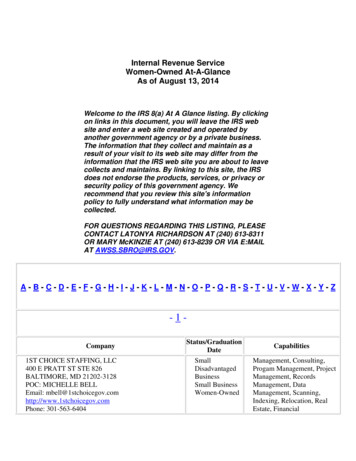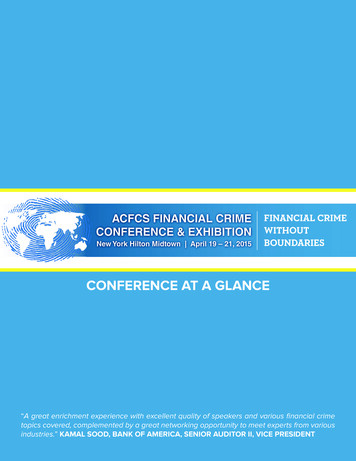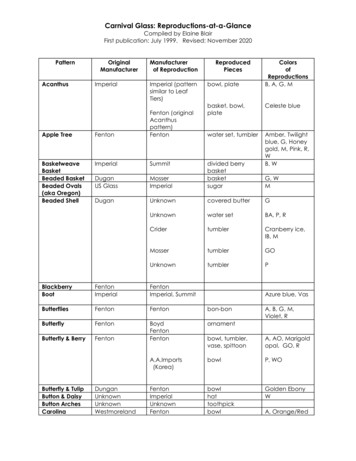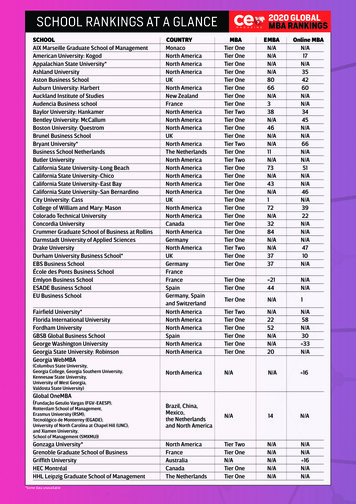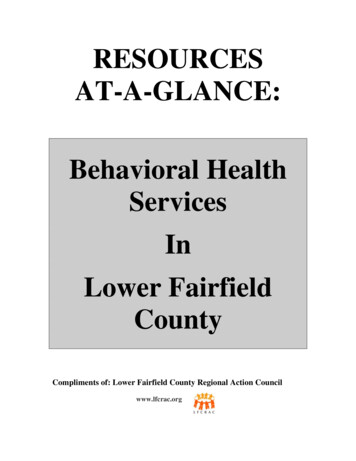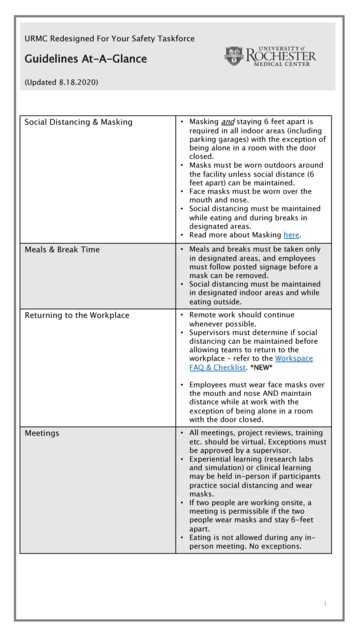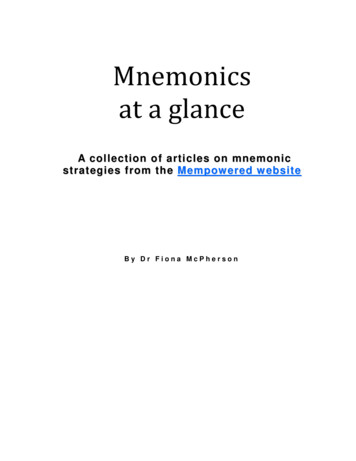
Transcription
Mnemonicsat a glanceA collection of articles on mnemonicstrategies from th e Mempow ered w ebsiteBy Dr Fiona McPherson
Other article collectionsActive readingLearning another languageMemory in normal agingHelping your aging memoryMemory impairment in the aging brainBooks by Fiona McPhersonEffective Notetaking (Study Skills)Mnemonics for Study (Study Skills)Planning to Remember: How to remember what you’re doing and what youplan to doPerfect Memory TrainingThe Memory Key
ContentsWhat mnemonics are, and what they are for . 5The value of lists . 5Imagery in mnemonics . 6Using mnemonics . 7Visual Vs Verbal Mnemonic Techniques. 9The myth of imagery . 10The Art of Memory . 11Verbal mnemonics . 14Coding mnemonic . 14First-letter mnemonics . 15The story method . 15Singing for Memory . 15Keyword method . 16How the keyword method works . 16When not to use the keyword method . 17Remembering backwards . 17Learn faster not better . 18Using the keyword method to learn vocabulary . 18Remembering for the long term . 18Are some keyword mnemonics easier to remember than others? . 19Controlled presentation . 20The importance of one-to-one instruction and the need for practice . 20Some words benefit more from the keyword mnemonic . 21How important is the image? . 21Is the keyword mnemonic of greater benefit to less able students? . 21
Comparing the keyword mnemonic to other strategies . 22Backward recall . 23Using the keyword mnemonic to remember gender . 23Why should the keyword mnemonic be an effective strategy? . 23Face-name association . 26Drawbacks to the face-name association method . 26List-learning strategies . 27The method of loci or place method . 27The pegword mnemonic . 28The link method . 28The story method . 28References . 29What mnemonics are . 29Visual Vs Verbal Mnemonic Techniques . 29The myth of imagery . 30The art of memory . 30Verbal mnemonics. 30Keyword method . 31Using the keyword method to learn vocabulary . 31Face-name association . 33List-learning strategies . 34
What mnemonics are, and what they are forAids to memory such as acronyms, rhymes, linking information by creating visual imagesor making up a story, are called mnemonics. Mnemonic strategies have beenrecommended as appropriate for remembering the following types of information: shopping listsvocabularyappointmentsspeechesfactsnames & facesdatesphone numbersideasjokesdramatic partspoemsnumbersMnemonics are undoubtedly effective for rote memorization, but they do require a lot ofwork to master.Mnemonics can also help you learn basic facts and new vocabulary, which you need toacquire when learning a new subject. However, mastering a subject is not simply a matterof knowing a lot. An expert has a well-organized network of memory codes into whichnew information can be easily integrated. Mnemonic techniques on their own do not helpyou understand the meaning of facts, and do not therefore help you develop expertise in asubject.Moreover, although mnemonics are usually the best strategies for memorizing by rote,for most tasks there are easier strategies which are sufficiently effective to be preferablefor many people: written or electronic records rote repetitionThe value of listsFor many tasks and for most people, a written list is far less effort, far more likely to beused, and far more reliable.Many people discard the idea of lists because they have found they usually forget to usethem. However, research has confirmed what many of us already know from experience— even if you forget to refer to your list, you are much more likely to recall items that you
have written down. The act of writing (and perhaps the opportunity to visualize your list)is sufficient to improve your memory.Imagery in mnemonicsVisual imagery underlies most mnemonic strategies. The best known are the list-learningstrategies — the method of loci, the pegword method, and the link method. While theseare undoubtedly effective strategies, they perhaps have less value as general strategic toolsthan the transformational elaborative strategies — the keyword method, and face-nameassociation.The role of imagery in helping memory is largely misunderstood (see the myth ofimagery). Methods that use words rather than images have been shown to be equallyeffective. Imagery has one major advantage, and that is the ease with which two items canbe connected using imagery. Imagery also has one major disadvantage, and that is thedifficulty many people have with creating images.Verbal mnemonic strategies include the use of acronyms, rhymes, and the more complexcoding method (for memorizing numbers) and the story method (the verbal equivalent ofthe linking mnemonic).When it’s best to use a mnemonic when information only need to be remembered for a short time as a reminder for well-learned information (to help overcome memory blocks; toremind you of the order of information) when written records are impossible, inconvenient, or inappropriate to anchor factsWhen it’s best to write something down when you need to remember the information for a long timewhen reliability and accuracy are importantwhen memory load is to be avoidedwhen information is coming at you too fastwhen the information is too complexReferences
Using mnemonicsLet's look a little deeper into the value of mnemonics for knowledge acquisition. By“knowledge acquisition”, I mean the sort of information you learn from textbooks —information that is not personal, that you need for the long-term.In this context, I believe the chief value of mnemonic strategies is to help you recallinformation that needs to be remembered in a particular order. Thus we use mnemonicsto help us remember the order of the planets, the order of musical notes on the stave, theorder of the colors in a rainbow.Sometimes we impose an order to make something easier to remember. Thus, HOMESis an established acronym to help people remember the Great Lakes of North America(Huron, Ontario, Michigan, Erie, Superior). The order of the lakes has no meaning,except that, ordered in such a way, the initial letters form a word.Notice that, of course, the sole assistance this acronym offers is to serve as a remindercue, by telling you the initial letters of the lakes (and how many there are). You have toalready know the names of the lakes.Other mnemonics for the Great Lakes provide slightly more information, by involving ameaningful order. Thus, “Sam's Horse Must Eat Oats” orders the lakes according to size,and “Sergeant Major Hates Eating Onions” tells you the order of the lakes from west toeast.None of these help you remember the actual names of the lakes.You could use words similar in sound to the lakes’ names, to help in remembering thenames. However, this may well result in a mnemonic that is harder to remember. Forexample, “Superior Mitch Again sees a Herons’ Eyrie Entire” makes far less sense and is amuch harder sentence to remember than “Sergeant Major Hates Eating Onions”.All this emphasizes the main point about mnemonics, a point that sometimes gets a littlelost in the shuffle. Mnemonics are adjuncts to learning. They have their place, and they areextremely effective for their purpose, but you have to remember that their purpose is verylimited. Thus, if you wished to learn the Periodic Table of Elements (a question aboutways of memorizing the Periodic Table was actually what provoked this article), then youcould simply devise a first-letter mnemonic for the table, such as:He Helps Limping Beggars Borrow Crutches Nicely Or Fairly Near. NaturallyMagazines Allow Simple Punctuation Should Clear Arguments. (the first 18 elements, i.e.,the first three rows of the Table).And of course, this won’t help you in any way if you are not already very familiar withthe names of the elements. Nor will it tell you anything at all about the significance of thePeriodic Table.Why would you want to memorize the Periodic Table of Elements?
I don’t mean this question to indicate contempt for the task, I actually believe deeply inthe value of having core information tamped down, as it were, deep into your knowledgebase. You cannot develop any expertise in a subject without knowing the core facts —really knowing, in the same way you know your name and birthdate and, maybe, thenames of the players in your favorite sports team, or the words to a favorite song, or thenames of the characters in your favorite TV show. (Mnemonics do not, in fact, play a rolewhen you have that depth of knowledge. Once you know something at the level of instantaccessibility, you don’t need a mnemonic. But mnemonics can be of great help in the earlystages of developing your knowledge.)But let’s return to the question. Why do I ask it? Because, whenever you want to learnsomething, you should ask yourself why. Not in the spirit of “does it really matter?”, butwith the purpose of establishing precisely your goal. Notice the word “precisely”. It’s notenough to simply say, “Well, I need to know the Periodic Table because I’m studyingchemistry, and the teacher tells me I have to know it.” Why does your teacher insist youlearn the Periodic Table? How does it help your understanding of chemistry?The Great Lakes of North America are simply several large bodies of water ingeographical proximity. Knowing their names is of no deep significance, has no largermeaning. The Periodic Table, however, does have larger meaning. The order of elementsis no arbitrary thing, and the placement of an element in a particular place in the Table isdeeply significant.The Periodic Table arranges the elements in such a way as to demonstrate the patternunderlying the physical and chemical similarities between elements. If you know where anelement is in the Table, you know a great deal about the element.To know that, however, you must understand a great deal more about the Periodic Tablethan simply the order of the elements. The order of the elements tells you nothing initself.So, what is it that you really need to know? Not the order, as such. Not simply:Hydrogen Helium Lithium Beryllium Boron Carbon Nitrogen Oxygen Fluorine NeonSodium Magnesium Aluminum Silicon Phosphorus Sulfur Chlorine Argon PotassiumCalcium Scandium Titanium Vanadium Chromium Manganese Iron Cobalt Nickel CopperZinc Gallium Germanium Arsenic Selenium Bromine Krypton etc. The Periodic Table
Mnemonics can also help you learn basic facts and new vocabulary, which you need to acquire when learning a new subject. However, mastering a subject is not simply a matter of knowing a lot. An expert has a well-organized network of memory codes into which new information can be easily integrated. Mnemonic techniques on their own do not help you understand the meaning of facts, and do not .File Size: 682KBPage Count: 34
